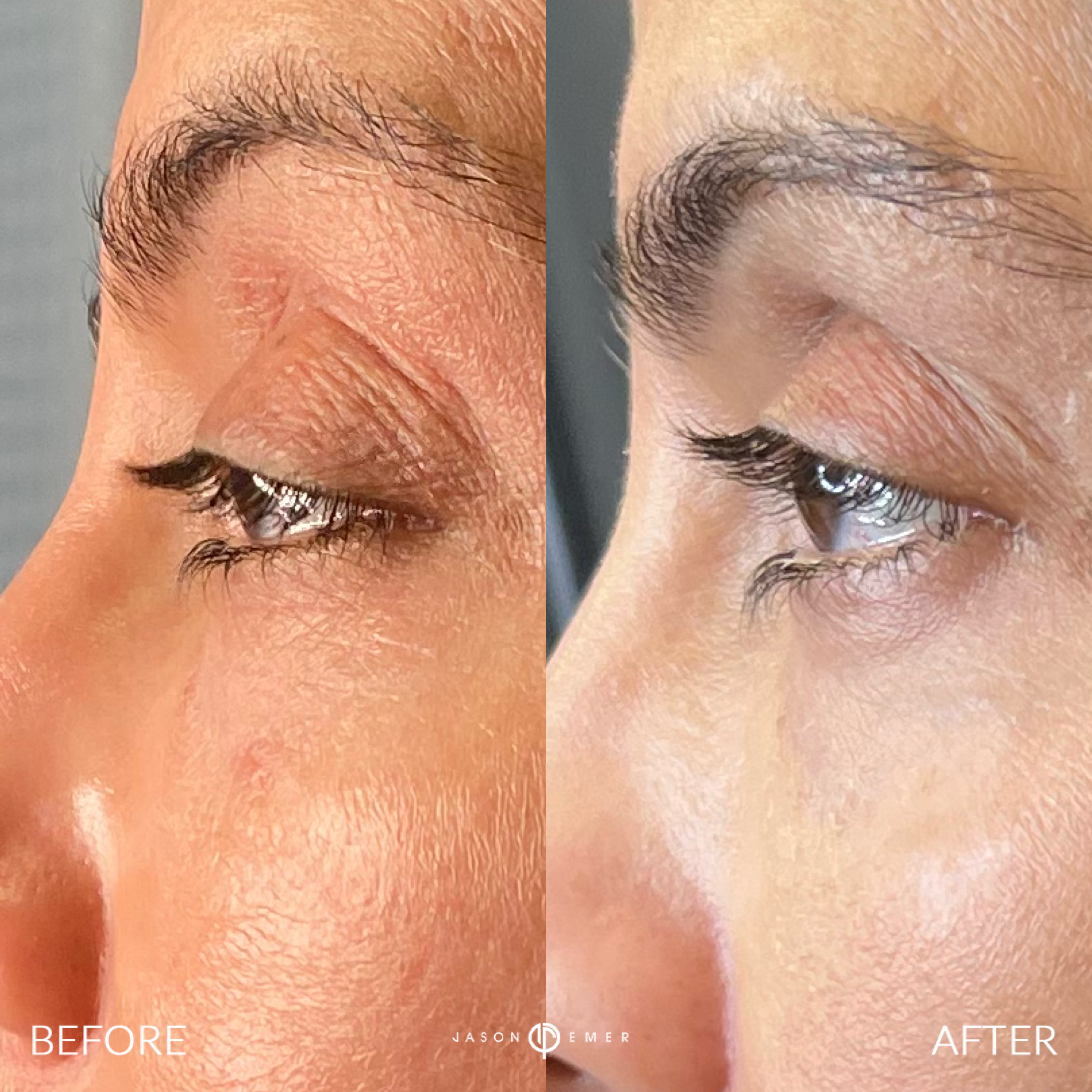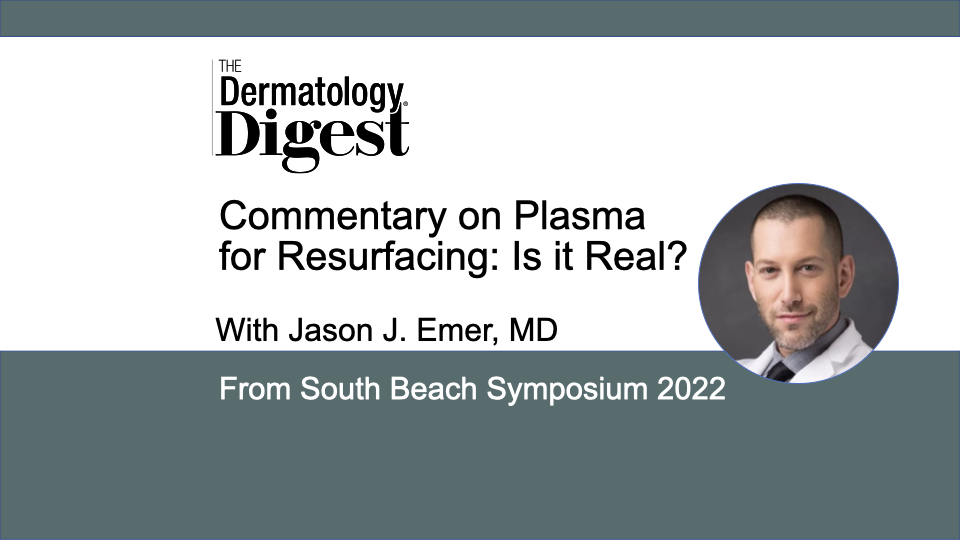Dr. Jason Emer shares his experience with plasma pen technology for skin tightening, including device selection, application, and skincare regimens.
Jason Emer, MD, is a board-certified dermatologist, cosmetic dermatologist, and surgeon in Beverly Hills, California
“Even today despite all the pens that exist… there are still a lot of complications and I see them especially in darker skin tones,” said Jason Emer, MD, who presented “Plasma for Resurfacing: Is it Real?” at the South Beach Symposium this year.
“I’ll see a lot of people with worsening dark circles. I’ll see them with swelling that occurs for a significant amount of time or irregular treatment areas… and so that brought me to why I wanted to do this lecture specifically because I’ve had amazing outcomes. And the reason I’ve had amazing outcomes is because I’ve gone through the times where I didn’t have amazing outcomes.”
It’s the less-than-desirable outcomes that have generated controversy over the safety and efficacy of plasma pen technology, said Dr. Emer.
“I post these things [on social media] all the time and other dermatologists will write, ‘This is crazy. You shouldn’t be promoting this. Don’t do this.’ But they haven’t seen it in my hands. They’ve only seen some disasters. They haven’t seen the really good results.”
Video courtesy Jason Emer, MD
According to Dr. Emer, achieving desirable results is a multi-factorial process that includes technology, application, and skincare considerations.
Not All Plasma Pens Are Equal
Years of experience with the plasma pen have helped Dr. Emer to develop protocols for safe, effective, and predictable treatment in all skin types. It all begins by choosing the right device. For him it’s the Plasma Pen by Louise Walsh International, he said.
“There are lots [of plasma pens] that are out there and in some people’s hands they can do well, but this device specifically has a lot of differences, [including] the fact that it has the coiling to make it more of a plasma.”
Most plasma pens deliver energy to the tip so quickly, it acts more like electrical impulse than plasma energy, resulting in a greater potential for scarring, redness, and irritation, said Dr. Emer.
“They’re just distributing electrical impulses and that is not what plasma pen is supposed to be.”
Actual plasma energy is transmitted via electrical impulses in the air, not directly from pen to skin, which is what makes it more predictive and protective, said Dr. Emer.
“The pen never touches the skin, and the energy [is] converted through a coil into plasma. Plasma is safer, it’s a little more predictable, and it also gives us that level of skin tightening.”
This specific plasma pen also comes with various pin sizes that allow the dermatologist to treat and blend wrinkles strategically, said Dr. Emer.
“If someone has deeper wrinkles—if you want to treat areas like folds or [the] neck—you’re not having to make a million dots all over the place… Or if someone has very fine wrinkles, you can use much smaller [pins] and you can even laser at the same time and blend the area and get the tightening plus the brightening.”
The Louise Walsh Plasma Pen is also easier to use, said Dr. Emer.
“A lot of the other ones, you have to literally flex your wrist 90 degrees to make it a perfect beam 90 degrees to the skin, where this one’s ergonomic. So even if your hand is a little angled, it’s still going to fire at 90 degrees perfectly on the skin, which is more protective for user error or if… they move their hand or the person sneezes or something and you don’t want the beam to go flying all over the place.”
Apply the Pen Appropriately
According to Dr. Emer, with the right pen and the right training, this plasma technology is the right choice for focal areas on the face and neck.
“Don’t go and treat your full face and neck with a plasma pen. That’s not what it’s designed for. You know these Instagrams where people are doing half the forehead and trying to lift the eyebrow or an entire neck and tightening? It’s not made for that. It’s made for focal areas.”
Use it in combination with lasers for larger areas, said Dr. Emer. Even better, think plasma pen plus microcoring as that technology becomes more widely available.
“That I think is going to be combined with this, giving an amazing tightening result because the downtime is going to be much less than it would be with lasers.”
Skincare Matters
According to Dr. Emer, good results require pre- and post-prep peels and products that include active ingredients such as retinol, hydroquinone, vitamin C, peptides, and stem cells. These are key to his product line and available in the AERIFY kit his patients use before and after treatment to enhance results and limit complications.


50-year-old female patient shown before and 11 months after receiving Plasma Pen treatment around the eyes to treat fine lines and skin laxity. Emerageskin Aerify Kit, Re-Fit Eye, and Aox-C Botanical Serum were used post-treatment. Images courtesy Jason Emer, MD
“I’ve done every single skin type, including African American. With the right pre and post skincare…you can combine lasers with plasma pen. You can combine plasma pen with other treatments like micro needling or even peels. But you have to pre and post treat the skin.”
Stem cells and peptides trump Aquafor or other occlusives as post-treatment protective products because they offer additional benefits, including reducing redness, said Dr. Emer.
“There’s a company AnteAGE that makes probably the number one stem cell, which is human bone marrow stem cell. You apply those on the skin with the peptides that I have in my line. (It’s called Re-Fit Eye and Re-Fit Face.) Within one or two days the redness is gone.”
When using an occlusive, it does the job to hydrate and peel correctly, but it has a downside. It keeps the heat in and the treated skin is red for a long time, said Dr. Emer.
“I have found that dissipation of heat is much more important as long as that barrier and that hydration is there. So the hyaluronic acid, the stem cells, and now there are some other companies making very elegant barrier repair creams.”
As soon as patients peel, Dr. Emer instructs them to use the overnight retinol peel in his Emerageskin Aerify Kit.
“The day all the scabs fall off is the day they apply that mask at home, and that retinol helps the skin cells turn over even with that level of inflammation.”
Retinol promotes healing and collagen formation, which means better skin tightening, said Dr. Emer.
“I was teaching people and it’s funny because [you can see] everybody in the audience [is] in shock. They’re told …have everybody stop retinol before a laser or before an ablative treatment, or don’t put vitamin C or hydroquinone or active ingredients on a scab. But again, this is a microinjury. This is not a fully ablative treatment. This is not damaged skin.”
Disclosure: Dr. Emer is the owner of emerageskin and has been a past paid lecturer for Plasma Pen.

